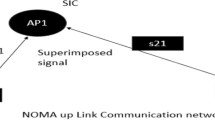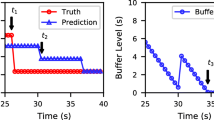Abstract
Most multimedia applications implement some kind of packet losses analysis mechanism to trigger self-adaptation actions. However, error recovery mechanisms such as ARQ variants avoid packet losses at IP level. Then, there appears an impact into the delay that may indeed result on application-level losses due to samples arriving later than the scheduled playout time. In most cases such degradations are not detected until they are so severe than even losses at IP level appear. We propose a lightweight method that achieves a finer grain estimation. We prove mathematically the capability of modified versions of statistics of delay to predict the error ratio of the wireless link and the load of the wired backhaul. After deducing also simplified heuristics for proposed method, we analyze their estimation capabilities and provide guidance for selecting appropriate parameters. Finally, we test and adjust the algorithm to an specific scenario including mobile video streaming and VoIP calls.













Similar content being viewed by others
References
Biaz, S., & Vaidya, N. (1999). Discriminating congestion losses from wireless losses using inter-arrival times at the receiver. In 1999 IEEE symposium on application-specific systems and software engineering and technology (ASSET’99) (pp. 10–17). New York: IEEE Press.
Bonfiglio, D., Mellia, M., Meo, M., & Rossi, D. (2009). Detailed analysis of Skype traffic. IEEE Transactions on Multimedia, 11(1), 117–127.
Boukerche, A., Jia, G., & Pazzi, R. (2007). Performance evaluation of packet loss differentiation algorithms for wireless networks. In Proceedings of the 2nd ACM workshop on performance monitoring and measurement of heterogeneous wireless and wired networks (pp. 50–52). New York: ACM.
Boyaci, O., Forte, A., & Schulzrinne, H. (2009). Performance of video-chat applications under congestion. In 2009 11th IEEE international symposium on multimedia (pp. 213–218). New York: IEEE Press.
Cen, S., Cosman, P., & Voelker, G. (2003). End-to-end differentiation of congestion and wireless losses. IEEE/ACM Transactions on Networking, 11(5), 703–717.
Chou, C., Hsu, M., & Lin, C. (2006). A trend-loss-density-based differential scheme in wired-cum-wireless networks. In Proceedings of the 2006 international conference on wireless communications and mobile computing (pp. 239–244). New York: ACM.
Fajardo, J., Liberal, F., Mkwawa, I., Sun, L., & Koumaras, H. (2010). QoE-driven dynamic management proposals for 3G VoIP services. Computer Communications.
Farrera, M., Fleury, M., Ghanbari, M., & Guild, K. (2008). Measurement study of packet loss versus delay in congestion detection for video streaming. In IEEE international conference on multimedia and expo (pp. 449–452). New York: IEEE Press.
Farrera, M., Fleury, M., Guild, K., & Ghanbari, M. (2010). Measurement and analysis study of congestion detection for Internet video streaming. Journal of Communications, 5(2), 169–177.
Hoßfeld, T., & Binzenhöfer, A. (2008). Analysis of Skype VoIP traffic in UMTS: end-to-end QoS and QoE measurements. Computer Networks, 52(3), 650–666.
Hsiao, H., Chindapol, A., Ritcey, J., Chen, Y., & Hwang, J. (2005). A new multimedia packet loss classification algorithm for congestion control over wired/wireless channels. In IEEE international conference on acoustics, speech, and signal processing (ICASSP’05) (Vol. 2). New York: IEEE Press.
Ikegawa, T., & Takahashi, Y. (2007). Sliding window protocol with selective-repeat arq: performance modeling and analysis. Telecommunications Systems, 34, 167–180.
Jammeh, E., Fleury, M., & Ghanbari, M. (2007). Delay-based congestion avoidance for video communication with fuzzy logic control. In Packet video 2007 (pp. 8–17). New York: IEEE Press.
Jammeh, E., Mkwawa, I., Khan, A., Goudarzi, M., Sun, L., & Ifeachor, E. (2012). Quality of experience (QoE) driven adaptation scheme for voice/video over IP. Telecommunications Systems, 49, 99–111.
Joshi, P. (1978). Recurrence relations between moments of order statistics from exponential and truncated exponential distributions. Sankhya. Series A, 39(4), 362–371.
Kleinrock, L. (1976). Queueing systems, vol. 2: Computer applications. New York: Wiley.
Lohier, S., Doudane, Y., & Pujolle, G. (2007). Cross-layer loss differentiation algorithms to improve TCP performance in WLANs. Telecommunications Systems, 36, 61–72.
Malkowski, M., & Heier, S. (2003). Interaction between UMTS MAC scheduling and TCP flow control mechanisms. In International conference on communication technology proceedings (ICCT 2003) (Vol. 2).
Papadimitriou, P., Tsaoussidis, V., & Zhang, C. (2010). End-to-end loss differentiation for video streaming with wireless link errors. Telecommunications Systems, 43, 295–312.
Park, M., Sihn, K., & Jeong, J. (2006). A statistical method of packet loss type discrimination in wired-wireless networks. In 3rd IEEE consumer communications and networking conference (CCNC 2006) (Vol. 1, pp. 458–462). New York: IEEE Press.
Ramadan, W., Dedu, E., Dhoutaut, D., & Bourgeois, J. (2011). RELD, RTT ECN loss differentiation to optimize the performance of transport protocols on wireless networks. Telecommunications Systems, 52(4), 1797–1817.
Rossi, M., & Zorzi, M. (2003). Analysis and heuristics for the characterization of selective repeat ARQ delay statistics over wireless channels. IEEE Transactions on Vehicular Technology, 52(5), 1365–1377.
Taboada, I., Liberal, F., & Fajardo, J. (2011). Delay modeling for 3G mobile multimedia services QoE estimation. In Mobilight 2011.
Tobe, Y., Tamura, Y., Molano, A., Ghosh, S., & Tokuda, H. (2000). Achieving moderate fairness for UDP flows by path-status classification. In Proceedings of the 25th annual IEEE conference on local computer networks (p. 252). Los Alamitos: IEEE Comput. Soc.
Wu, C., Chen, K., Huang, C., & Lei, C. (2009). An empirical evaluation of VoIP playout buffer dimensioning in Skype, Google talk, and MSN Messenger. In Proceedings of the 18th international workshop on network and operating systems support for digital audio and video (pp. 97–102). New York: ACM.
Author information
Authors and Affiliations
Corresponding author
Appendix: Calculus of truncated e2e delay
Appendix: Calculus of truncated e2e delay
The following calculus procedure is applied to the simplified CN scenario in Sect. 4 under the M/M/1 assumption. However, a totally equivalent one can be applied to other delay distributions either analytically or by applying inverse Laplace numerical methods. We have included such calculus here in order to obtain a closed analytical expression by using the Laplace transform, a common method for computing waiting time in queuing systems (see [16]). This way, there would be no need to compute the inverse Laplace transform of D CN . Instead, we should compute the convolution directly.
Then, the objective of the calculus is to compute the PDF of the ideal truncated distribution (probability of truncated first retransmission section) \(D'_{\mathit{AN}}=D'_{\mathit{AN}_{1}}\). Considering that \(\sqcap_{\mathit{TTI}}{ (t-\frac{\mathit{TTI}}{2} )}=u(t)-u(t-\mathit{TTI})\) where u(t) is the Heaviside step function, we can obtain the Laplace transform:

Similarly for D CN (t) (taking advantage of methods in [16]).

The convolution in time is the product in Laplace ‘s’-domain:

Considering that  expression
expression  can be calculated as:
can be calculated as:

Similarly for  :
:

Finally we obtain the whole expression for \(D'_{e2e}\) considering the effect of D TTI , considering that K, the constant to make the area of the PDF equal to 1, has the following expression:
Then:
Therefore:
Rights and permissions
About this article
Cite this article
Liberal, F., Taboada, I. & Fajardo, J.O. A lightweight network state estimation mechanism in ARQ-based wireless networks. Telecommun Syst 57, 137–157 (2014). https://doi.org/10.1007/s11235-013-9810-2
Published:
Issue Date:
DOI: https://doi.org/10.1007/s11235-013-9810-2




